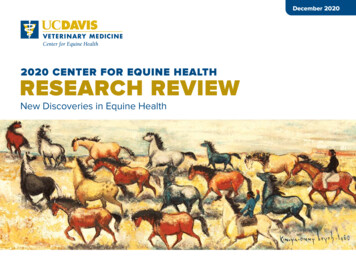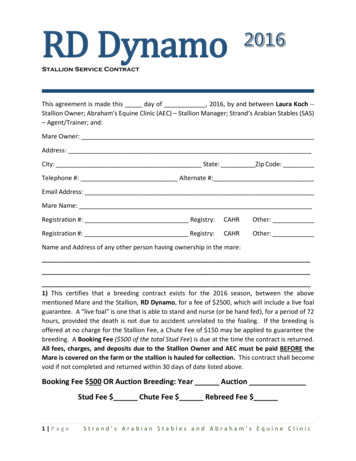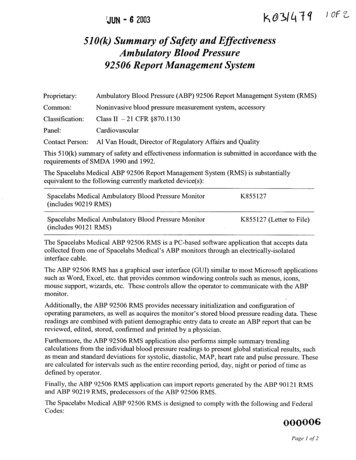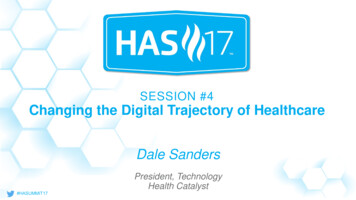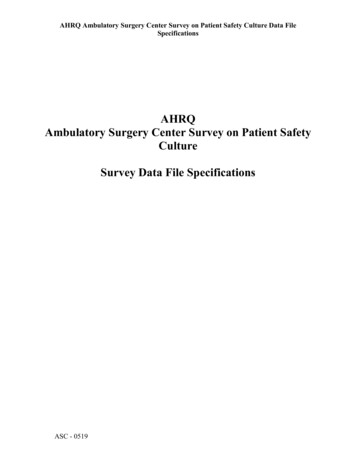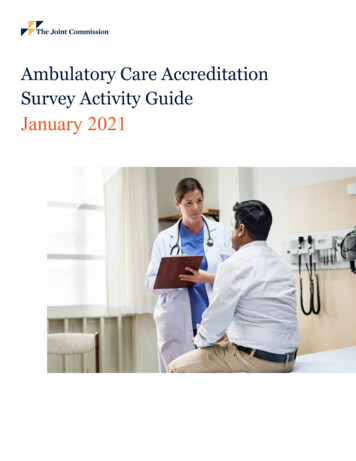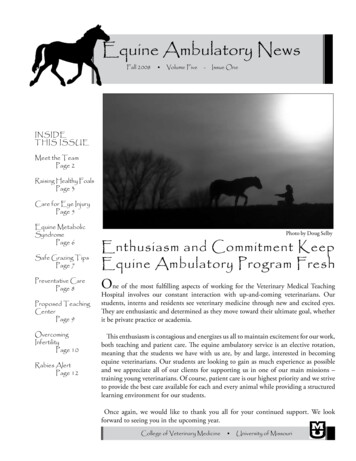
Transcription
Equine Ambulatory NewsFall 2008 Volume Five-Issue OneINSIDETHIS ISSUEMeet the TeamPage 2Raising Healthy FoalsPage 3Care for Eye InjuryPage 5Equine MetabolicSyndromePage 6Safe Grazing TipsPage 7Preventative CarePage 8Proposed TeachingCenterPage 9OvercomingInfertilityPage 10Rabies AlertPage 12Photo by Doug SelbyEnthusiasm and Commitment KeepEquine Ambulatory Program FreshOne of the most fulfilling aspects of working for the Veterinary Medical TeachingHospital involves our constant interaction with up-and-coming veterinarians. Ourstudents, interns and residents see veterinary medicine through new and excited eyes.They are enthusiastic and determined as they move toward their ultimate goal, whetherit be private practice or academia.This enthusiasm is contagious and energizes us all to maintain excitement for our work,both teaching and patient care. The equine ambulatory service is an elective rotation,meaning that the students we have with us are, by and large, interested in becomingequine veterinarians. Our students are looking to gain as much experience as possibleand we appreciate all of our clients for supporting us in one of our main missions –training young veterinarians. Of course, patient care is our highest priority and we striveto provide the best care available for each and every animal while providing a structuredlearning environment for our students.Once again, we would like to thank you all for your continued support. We lookforward to seeing you in the upcoming year.College of Veterinary Medicine University of Missouri
Meet the University of MissouriEquine Ambulatory TeamPUBLISHEDANNUALLY BYTHE EQUINEAMBULATORYSECTIONOF THEUNIVERSITY OFMISSOURICOLLEGE TALMission StatementThe mission of our equineambulatory service is toprovide the highest standard of medical and surgical care to our patientswhile training the nextgeneration of veterinarians. We feel we are trulyattaining this goal by working together as a team.900 East Campus DriveVeterinary MedicalTeaching HospitalUniversity of MissouriColumbia, MO 65211Dr. Alison LaCarrubba, originally from New York, graduatedfrom the University of Missouri College of Veterinary Medicinein 2001. Alison stayed on at MU to complete an internship inequine medicine and surgery. After the internship, Alison spenta year working in an equine exclusive private practice with aspecial interest in reproduction. She returned to the university inJuly 2003. Although the majority of Alison’s time is spent in theambulatory truck, she also devotes some time to working withthe medicine section in the teaching hospital. She is beginningthe process of receiving certification with the American Board ofVeterinary Practitioners, Equine Specialty.Dr. Dawna Voelkl was born and raised in western Pennsylvania,near Pittsburgh. Dawna graduated from Cornell University Collegeof Veterinary Medicine in 2003, after which she spent one year atthe University of Minnesota working in large-animal medicine,surgery and reproduction. She then completed a residency in largeanimal clinical reproduction with an emphasis on the horse at NewBolton Center of the University of Pennsylvania. In August 2006,Dawna earned board certification in theriogenology (veterinaryreproduction). Within the field of equine reproduction, Dawnahas particular interest in working with breeding stallions, semenfreezing and embryo transfer, and she has expanded thereproductive services offered by the Equine Ambulatory Service.Dr. Alison LaCarrubbaDr. Dawna VoelklOur interns have a special interest in working with horses, and potentially goingon to complete a residency, specializing in either equine medicine or equine surgery.Every June we welcome a new crop of interns. This year ourinterns include Dr. Martha Rasch, Dr. Loni Taylor and Dr.Jennifer Day.Dr. Martha Rasch was born in Chicago, Ill., and grew upriding hunters and jumpers in St. Louis, Mo. She began toride in three-day events while studying animal sciences atthe University of Missouri. In May 2008, Martha graduatedfrom MU’s College of Veterinary Medicine. Her areas ofinterest include ambulatory practice and internal medicine.After completion of her internship, Martha plans to work as aprivate equine ambulatory practitioner.Dr. Martha RaschDr. Loni Taylor grew up in Hope, Ark., competing in local 4-H, NBHA, andArkansas Horse Show Association shows.Continued on page 3Equine Ambulatory News Fall 2008Page 2
Raising Healthy FoalsAn Ounce of Prevention Goes a Long WayExpecting a foal is a time of great ex-citement. After waiting almost a fullyear for the new arrival you want toensure that the foal receives the bestcare possible. There are a few thingsthat you can do to promote the arrivalof a healthy foal – this starts with taking care of the mare. Be sure that themare has been properly vaccinated,dewormed and is receiving adequatenutrition prior to foaling. Once thefoal hits the ground, there are milestones that you need to know.The following is a list of these milestones and the time frame in whichthey should occur: Stretching and breakage of theumbilical cord one to two minutes after birth;Normal breathing efforts within one minute;Attempts to stand within 30minutes after birth;Ability to stand unassistedwithin one to two hours;Internscontinued from page 2Dr. Loni Taylor Nursing from the mare withinone to three hours;Nursing multiple times eachhour;First stool (meconium) shouldpass within six to 12 hours.If any of these events do not occurwithin the normal time frame, thereis a chance that something is wrongwith the foal. Problems with foals arebest addressed early and aggressivelyContinued on page 4After high school, Loni attended Southern Arkansas Universitywhere she was a member of the rodeo team. Loni graduated witha bachelor’s degree in agriculture science from Southern ArkansasUniversity in 2004, and her DVM from the University of Missouriin 2008. Loni’s veterinary interests include reproduction, ambulatorymedicine and neonatal medicine. After her internship, Loni plans towork in private equine practice.Dr. Jennifer Day has lived all over the country, but her mostrecent hometown is Suffolk, Va. She completed her pre-veterinaryrequirements and veterinary degree at Auburn University inAlabama. Her areas of interest include equine internal medicineand emergency and critical care. After completing her internship,Jennifer plans to pursue a residency in equine internal medicine anda fellowship in emergency and critical care.College of Veterinary Medicine Dr. Jennifer DayUniversity of MissouriPage 3
fluids, gastrointestinalprotectants, and antibiotics, depending uponthe suspected cause ofthe diarrhea.PreventionContinued from page 3to ensure a positive outcome. Whilekeeping a close eye on your new foalis critical, it is also important that youdo not interrupt the mare-foal bond.It is recommended that you do notenter the stall frequently during thefirst few hours of life, but rather observe from a quiet location outsidethe stall.It is critical that all new foals nursewithin the first hour of life in order to ingest the valuable first milk.This first milk, or colostrum, is bestabsorbed by the foal within eight to12 hours of birth. After 24 hours, thefoal’s gastrointestinal (GI) tract losesthe ability to absorb the antibodiesin colostrum and the window of opportunity for oral absorption of colostrum closes. Foals that have notreceived an adequate amount of colostrum, or those that received poorquality colostrum, are at higher risk ofdeveloping infections that can resultin life-threatening problems, such asrespiratory disease, diarrhea and sepsis. Sepsis occurs when bacteria enterthe blood and seed to different organsystems and joints.Diarrhea is a common complicationwhen a foal has not received adequateclostrum. Foal diarrhea can be causedby a multitude of sources, which aretypically broken down into infectiousor non-infectious.Infectious causes of foal diarrhea include bacteria, viruses and parasites,such as rotaviruses, clostridial organisms, Salmonella, Rhodococcus equiand Actinobacillus. Non-infectiouscauses can be attributed to lactose intolerance, toxins, or “foal heat” diarColostrum contains antibodies that rhea. Foal heat diarrhea refers to norhelp the foal defend against viruses mal changes in the foal’s GI tract andand bacteria that they come in con- usually occurs seven to 14 days aftertact with during the first few weeks of birth, often coinciding with the mare’slife. A blood test can be performed by first post-partum heat cycle.your veterinarian 18 to 24 hours afterIt is important that a veterinarianbirth to determine if the foal receivedevaluate foals with diarrhea becauseadequate colostrum. When examinthese foals can develop life-threatening a foal that is 24 hours old or oldering dehydration in as little as a fewthat has not ingested enough of thishours. Dehydration occurs more rapvaluable first milk, the only reliableidly in foals because of their small sizeway to provide immediate protectionand immature gastrointestinal tracts.against pathogens is to administer intravenous plasma, which is rich in theTreatment of diarrheic foals conneeded antibodies.sists of hospitalization, intravenousEquine Ambulatory News Good farm management is crucial for preventing diarrhea andother infectious diseases in foals. The followingmanagementtechniques will helpto minimize disease innewborns: Ensure that the marereceives adequate nutrition and provide a constant clean water source; Test foals for adequatecolostrum at 24 hours of age;Isolate new mares and foals prior to joining the herd;Vaccinate pregnant mares onemonth prior to foaling. Thiswill increase the quality of antibodies that the mare will produce in her colostrum;Harrow pastures and clean stallsto decrease parasite load;Deworm mares prior to foaling;Have a clean environment available for foaling;If moving your pregnant mareto a new barn prior to foaling,be sure to move her four to sixweeks before she is due to foal.This will allow her time to buildup antibodies to the local environment, which will then bepassed to the foal in colostrum.When you spend a year preparing for the arrival of a new foal, it isworthwhile to take measures to ensure that the foal will have the bestchance at a long and healthy life. Fall 2008Page 4
Case Study:Eye Problems Demand Immediate CareThunderis a 13-year-old mixedbreed pony that presented to theequine ambulatory service for an eyeinjury. Thunder’s owner noticed thathis eye was cloudy and tearing andcalled for an appointment immediately. Upon presentation Thunderwas bright and alert, although it wasobvious there was a problem with hisright eye. Further examination of theeye revealed excessive tearing, diffuseopacification of the cornea (the eyelooked white and cloudy), a cornealulcer present near the medial canthus(toward the nose) and a brown spot atthe center of the ulcer.retina was intact. If the retina had detached at the back of the eye, then wewould be unable to preserve vision.The retina was found to be in the correct location. Although many horsesThe ambulatory team was con- and ponies go on to have a long andcerned that the brown spot in the productive lives with only one eye,center of the ulcer represented a place the owner elected to attempt to savewhere the eye had ruptured. We were the eye and preserve vision. Thundernot sure if the brown pigment rep- was immediately taken to surgery.resented Thunder’s iris protrudingDuring an hour and a half of surthrough a defect in the cornea, or ifgery, using a microscope to visualizeit was a foreign body. Either way wethe cornea, a splinter was removedknew that this was a serious problemfrom Thunder’s eye and a patch of tisthat needed immediate attention ifsue was sutured over the defect in thethe eye was going to be saved.cornea. Thunder recovered uneventThunder was referred to the Veteri- fully from anesthesia and was able tonary Medical Teaching Hospital for walk back to his stall by early evening.examination by the ophthalmology Although the splinter was removed,service within hours of the initial call. we were still unsure if Thunder wouldThe specialists confirmed the presence be able to overcome the severe infecof a corneal ulcer and a severe infec- tion. To facilitate treatment of thetion in the eye, along with the pig- eye, a device called a sub-palpebral lament at the center of the ulcer. They vage tube was placed under the lowersuspected a foreign body, such as a eyelid. This tube allowed all of thepiece of wood, although this could eye medications to be given throughonly be confirmed at surgery. An ul- a long tube which coursed down thetrasonographic examination was per- neck and was tied into the mane. Theformed on the eye to determine if the eye medications were given as freCollege of Veterinary Medicine quently as every two hours over thefirst days of treatment, so the horsereally appreciated this tube. Thunderwas also started on systemic antibiotics and pain medications.At one week post surgery, Thunderstill had some pain and inflammation,but the infection was under controland the surgery site was healing well.The eye continued to be treated aggressively to prevent infection andpromote healing, but Thunder washome and the prognosis was good.Six weeks after surgery, Thunder’s eyehad healed with great use and minimal scarring.Special thanks goes to the ophthalmology service for providing promptand skilled service and turning a badsituation into a positive experiencefor client and patient.All of us who work with horsesknow just how sensitive they are andjust how quickly things can go wrong.We can’t impress upon you enoughthe importance of having any problem associated with the eye examinedas soon as possible.University of MissouriPage 5
EquineMetabolicSyndromeAn EmergingEpidemicThe lifestyle of contemporary, domestichorses differs greatly from the nomadic,grazing existence in which they evolved.The same slow metabolism that onceserved as an evolutionary advantage forsurvival on poor-quality forage can lead todangerous weight gain and glucose-toxicitywhen combined with modern, energyrich feeds and limited exercise. Horsesclassified as “easy-keepers” appear virtuallyimmune to even the most drastic calorierestriction. Unchecked, their seeminglyunstoppable weight gain may lead to aseries of potentially serious consequencesand a condition referred to as equinemetabolic syndrome.unpredictable cycling pattern. And, mostdevastatingly, chronically afflicted horses areoften diagnosed with laminitis, or founder.The effects of equine metabolic syndromestem from a generalized resistance to insulin,similar to type II diabetes in people. Insulinis a normal, pancreatic hormone responsiblefor transport of high levels of glucose out ofthe bloodstream for subsequent use by thebody’s cells. However, a horse with equinemetabolic syndrome has a decreased responseto insulin, caused by fat-derived hormonesand an inherently low metabolism. Thisinsulin resistance allows toxic levels of glucoseto build in the blood stream. Laminitisis often the end result of chronic insulinresistance and hyperglycemia, although theEquine metabolic syndrome is triggered mechanism by which this occurs remainsby excessive consumption of high-quality largely unknown.feeds, leading to chronic elevations inEquine metabolic syndrome is typicallyglucose levels. These horses are commonlyoverweight, even on very little feed. first identified in middle-aged horses,This weight gain is often not uniformly but has been seen in horses 6-20 yearsdistributed, but rather focally deposited old. Although seen most commonly inin the crest of the neck, shoulders, rump, pony breeds, Spanish mustangs, Peruvianat the tail head, and in the sheath of male Pasos, Paso Finos, European Warmbloods,American Saddlebreds, and Morgan horses,horses. Additionally, affected mares canContinued on page 7be hard to breed due to an abnormal andEquine Ambulatory News Fall 2008Page 6
Metaboliccontinued from page 6equine metabolic syndrome can affectany breed. Your veterinarian canperform the definitive test of equinemetabolic syndrome – a glucosetolerance test. This test involves aseries of blood draws to assess glucoseand insulin levels after intravenousglucose administration.While no specific medicationsexist to treat equine metabolicsyndrome, several strategies can beemployed to prevent or reduce theeffects of the condition. Primarily,a low-carbohydrate diet should beestablished to reduce the intake ofsimple sugars. The diet should consistof mostly hay and, if necessary, nonstarch alternative feeds (beet pulp),never allowing these horses access tograin or unlimited pasture.would be prudent to run an analysisof the NSC content. The safest hayfor affected horses has, on average,less than 10 percent NSC. A way todecrease the amount of sugar in thehay is to soak hay for one to twohours prior to feeding. Be aware thatsoaking hay for too long can resultin mold formation which would bedetrimental to the horse’s health.increased exercise can help affectedhorses to ward off obesity and caneven improve their insulin sensitivity.Finally, while there is no definitivecure for laminitis, foundered horsescan be carefully managed by yourveterinarian and farrier throughcorrective shoeing, restricted turnout and pain control.Fortunately, management of equineFor turn-out, affected horsesshould be kept on a dry-lot or in a metabolic syndrome is possible andWhen feeding hay to horses affected grazing muzzle to prevent excess can significantly improve the qualityby equine metabolic syndrome, it consumption of grass. Additionally, of life for affected horses.Grazing Tips for Horses with Equine Metabolic Syndrome, LaminitisAs Equine Metabolic Syndromeand insulin resistance continue toincrease in significance among ourhorse population, it is important tolearn how to better care for and feedour affected equine friends. Recently, Kathryn Watts spoke on thetopic of grazing horses with EquineMetabolic Syndrome (EMS) at theWhen feeding obese horses or horsessuffering from EMS and laminitis,it is important to utilize feeds thatprovide balanced protein and mineral content, but are low in nonstructural carbohydrates (NSC).Non-structural carbohydrates consist of simple sugars, disaccharides,fructans and starch.Missouri Veterinary Medical Association equine summer continuingeducation meeting. Watts has morethan 25 years of experience in agricultural contract research and consulting. Much of what was writtenhere has been taken from her lecture and can be found online at herWeb site, www.safergrass.org.Much of the grass we see in Misver the last three decades re- improve cold and drought tolerance. souri is considered cool season grass.search on forage quality has been Only recently have we realized that Examples of cool season grasses indirected toward the production ani- perhaps the characteristics that sup- clude fescue, brome, orchard grass,mal that aims to increase nutrient port quality food-animal production rye, and timothy. Heat and colddensity, increase sustainability and actually may be harming our horses.Continued on page 8OCollege of Veterinary Medicine University of MissouriPage 7
Grazingcontinued from page 7stress, along with drought conditionswill change the composition of thegrass rapidly and alter its sugar levels.When night temperatures drop below40 degrees, the plant stops growingand sugar levels rise. In effect, horsesgrazing pasture during the spring andfall when temperatures frequently oscillate are eating grass that varies insugar content not only from day today, but from day to night. This constant state of flux can be problematicfor horses suffering from laminitis.The production of sugar is directlycorrelated with light intensity and duration. The content of the sugars foundin grass will be at its lowest betweenthe hours of 3 to 10 a.m. when temperatures at night are above 40 degrees.Sugar levels rise when the sun comesup and peak in the mid afternoon.Along with this, drought stress results in an accumulation of simplesugars in the grass. Grass that is justabout to go to seed, or has just goneto seed has the highest content ofPreventativeCareVaccinations andDentistryin simple sugars and somewhat lesspalatable. Some practical tips to safegrazing that can be helpful to you andyour horse include rotational grazing,restricted grazing, restricted grazingduring times of highest stress andoptimizing fertility and soil pH. Restricted grazing can be accomplishedin two ways: You can put your horsein a dry lot for part of the day, or agrazing muzzle can be applied.Horses that are at risk for laminitisshould be kept off of grass altogetherduring the periods when the nightsare below 40 degrees and the NSClevels are so variable. This period typically lasts six weeks in the spring andsix weeks in the fall. Allowing horsesto graze during the overnight periodand pulling them off of pasture duringpeak NSC times can also be useful. Fisimple sugars throughout the seed,nally, soil should be analyzed and ferleaf and stem.tilized accordingly. Nutrient deficiencies that retard growth tend to increaseWhen trying to determine a safe andthe NCS concentration of grasses.effective grazing scheme for horses affected by EMS, obesity or laminitis,For more tips on how to safely grazeit may not be practical to tear out all horses affected by EMS or laminitis,of your pastures and replant with na- please feel free to call and talk withtive species, which are typically lower one of our doctors.Remember, in addition to routine vac-cinations, brood mares require a rhinopneumonitis booster during their fifth,seventh, and ninth month of gestation inorder to help prevent abortions and weakfoals. It is also important to administer allrecommended vaccines one month priorto the mare’s expected foaling date in order to increase antibody content of themare’s colostrum. If you have any questions regarding vaccinations, please call usand we can discuss a vaccination schedulethat fits your horse’s needs.speculum and power equipment allow usto address the common dental issues, suchas sharp enamel points, as well as providethe ability to deal with more significantproblems on the farm. A thorough dentalQuality dental care is critical to the examination and annual float is critical towelfare of your horse. We recommend a the health and well-being of patients, andyearly dental examination. Our full mouth we are committed to providing that care.Equine Ambulatory News Fall 2008Page 8
New Facility Proposed toExpand Teaching, ServicesMissouri hasthe third largestequine population in the United States and theMU College ofVeterinary Medicine has a rich tradition in educatingstudents and veterinarians in the artand science of equine practice! Educating the next generation of veterinarians is an exciting challenge for allof us.Establishment of the Equine Teaching Center will be an important milestone in ensuring that we are able toprovide the very best experiences forour students, and will serve to improve Missouri’s equine herd health.Dr. Neil C. OlsonDean, College of Veterinary MedicineTeachingAs the only institution in the stateconferring a DVM, the College ofVeterinary Medicine at the Universityof Missouri graduates approximately75 students each year. Many of thesestudents go on to careers that includea presence in equine practice. Thecenter will offer the following: Space and facilities to enhancestudent instruction of practicalclinical skills; Proximate housing for horsesused for teaching on campus; Dedicated space for horse ownersand veterinary extension seminars, wetlabs and workshops; Facilities for whole animal teaching including palpation stocks,open areas and stables; Adequate space for equine theriogenology teaching.Service The Equine Teaching Center willnot only meet the need for state-ofthe-art educational facilities, it willalso provide improved options forequine care, treatment and services: Affordable horse stabling for healthy client breeding horses;Space to develop reproduction services, including semen collection;Affordable accommodations forclient-owned horses with con- ditions necessitating prolongedconvalescence.Other BenefitsThe Equine Teaching Center willoffer additional advantages to students and horse owners:College of Veterinary Medicine Accommodations for equine research projects and housing forhorses on campus within easy access of diagnostic modalities available in the Veterinary MedicalTeaching Hospital and VeterinaryMedical Diagnostic Laboratory;Turn-out paddocks for exercise ofteaching, research, and theriogenology horses, plus client-ownedhorses with conditions necessitating prolonged convalescence;Facilities readily serviced byVMTH staff and students,such as feeding, cleaning of stables, turn-out and night visits;Teaching and research horses separated from hospitalized, potentially disease-bearing animals forimproved biosecurity.University of MissouriPage 9
OvercomingBreedingIssuesExaminationCan ExposeFactors PreventingConceptionIt seems like such a natural thing – horsesFor a mare that enters the breeding season “barren,” i.e., the mare was bred durmate, the mare conceives, and then 340 ing the previous season but failed to delivdays later a foal is on the ground. Yet so er a foal at term, a comprehensive breedingmany times we find ourselves at the end of soundness exam is indicated to determinethe breeding season with a mare that is not the likelihood that the mare will conceive,pregnant. While infertility and early em- carry and deliver a live foal at term. Thebryonic loss are real problems in a relative- breeding soundness examination consistsly small population of mares, many cases of visual evaluation of the mare’s perinealof perceived infertility may be addressed conformation and mammary glands, exthrough simple and economic modifica- amination of the ovaries and reproductivetions in breeding management.tract by transrectal ultrasonography, examWhen planning a breeding, you should ination of the vagina and cervix, a uterineconsider the reproductive soundness of culture, and an endometrial biopsy.both the mare and stallion. While a comIf abnormalities are detected during thisprehensive breeding soundness examina- examination, additional diagnostics maytion on the stallion of interest is not prac- be pursued to evaluate your mare for suchtical in many situations, a pre-breeding problems as hormonal aberrations andsemen evaluation is desirable. If the mare structural abnormalities. Problems thatis to be bred to a non-local stallion using your veterinarian might identify on yourcooled, transported or frozen-thawed se- mare’s breeding soundness examinationmen, efforts should be made to discuss include poor conformation, cervical adhethe stallion’s semen quality and pregnancy sions, endometrial cysts, and ovarian abrates during prior seasons with the stal- normalities such as a granulosa cell tumor.lion’s owner, manager, or veterinarian priorContinued on page 11to committing to a breeding contract.Equine Ambulatory News Fall 2008Page 10
Fertilitycontinued from page 10If failure to conceive is a problemfor your mare, the first thing to consider is the quality of heat detection.Although certain mares show heatreadily there are others that will notobviously show heat unless they arepresented to a stallion. If you don’thave a stallion on your property to“tease” your mare, it would be bestto have your veterinarian perform atransrectal ultrasound examinationto assess where your mare is in hercycle. Your veterinarian can also administer medications to manipulatethe mare’s cycle and better plan whenshe will come into heat and be readyfor breeding.Another factor to consider whenbreeding your mare is day-to-daycare. If the plane of nutrition is inadequate and the horse is in poor bodycondition, the mare may experienceabnormalities of cyclicty, aspirate airand bacteria into the uterus, or poolurine near the cervical opening, allof which contribute to poor conception rates and early embryonic loss.Grossly overweight animals may alsosuffer from subfertility. Additionally,mares maintained in a stressful environment may fail to conceive or maylose an early embryo.In older (late teenage) mares, if nosignificant abnormalities are notedduring the breeding soundess examination and heat detection is optimal,you should consider normal age-related changes. Older mares, particularlymares that have not carried a foal, canhave endometrial fibrosis, or scar tissue, present that makes it difficult forthem to maintain a pregnancy. TheMaresmaintainedin a stressfulenvironmentmay fail toconceive ormay lose anearly embryo.ian during the breeding process andhave your mare examined by ultrasound early, as early as 14 days andno later than 16 days, to determinepregnancy. This will enable yourveterinarian to best deal with a twinpregnancy, if present. Additionally,your veterinarian can recommendnutrition and physical care, includingvaccination against equine herpes virus-1 at five, seven, and nine monthsOther abnormalities of reproducgestation; elimination of fescue fromtive that older mares can demonstratethe mare’s diet approximately twoare irregular cycles, sub-optimal oomonths before foaling; and routinecyte (egg) quality, and a predisposivaccinations at approximately onetion to uterine infection (pyometra).month prior to foaling. FollowingOverall, the best thing you can do these recommendations will increasewhen breeding your mare is to have the likelihood that you are welcoma good relationship with your veteri- ing a new addition to your farm thenarian. Consult with your veterinar- following season.presence and degree of endometrialfibrosis can be assessed by obtaining abiopsy. This information may then beused to help establish the probabilitythat the mare will be
private equine ambulatory practitioner. Dr. Loni Taylor grew up in Hope, Ark., competing in local 4-H, NBHA, and Arkansas Horse Show Association shows. Dr. Alison LaCarrubba, originally from New York, graduated from the University of Missouri College of Veterinary Medicine in 2001. Alison stayed on at MU to complete an internship in
